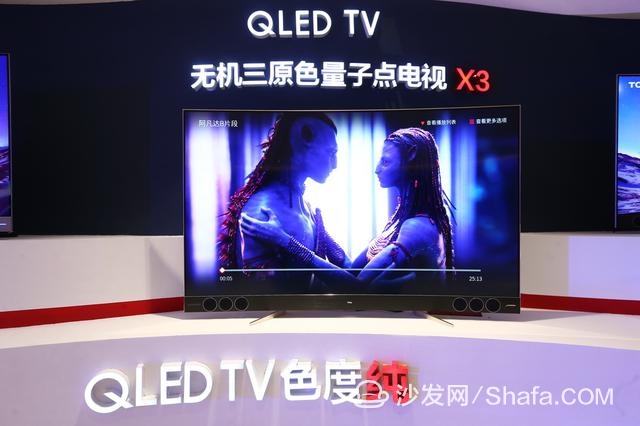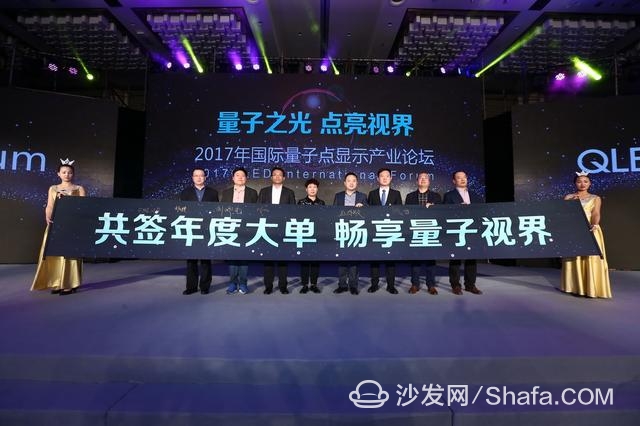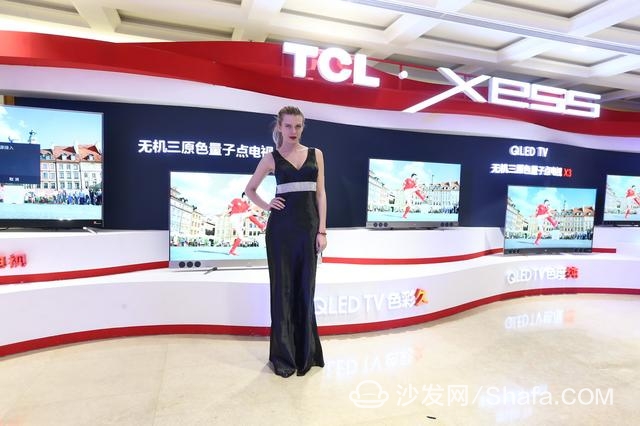
Why TCL?
In 2016, it was a memorable year for TCL. Especially in the television industry, TCL has become the world's top three television maker in China and the world’s No. 1 TV manufacturer with a global shipment of over 20 million TV sets. On behalf of the Chinese manufacturing and Japan and South Korea TV companies face a front. In particular, it is worth mentioning that in 2016, the high-end sub-brand XESS launched by TCL, the top flagship XESS X1 QD TV won a number of international awards at the CES show, earning a place in the high-end market where Japanese and Korean brands have dominated for years.
On March 29th, TCL XESS X2/X3 third-generation inorganic trichromatic quantum dot TVs, C2 theatre TVs, and P3 gold curved TV mid-to-high end series were unveiled, covering QD technology, top sound quality, curved surface HDR, and other fields. As a result, TCL won the "2017 German iF International Design Award", "CITE Innovative Products and Applications Gold Award", "Red Diamond Award" and other honors. As quantum dot technology matures, quantum dot display will usher in a rapid growth in the first year. As the leading brand of quantum dot technology, TCL actively promotes the application of quantum dot technology in the industry. More importantly, although the technology is leading, TCL is very close to the people in terms of price and promotion. The newly released new products have already started the sales promotion mode and have also shown TCL's determination to occupy the high-end TV market.
In fact, China's color TV industry is facing a critical stage of high-end development and upgrading of product structure. Quantum-dot TV breaks through the ceiling of LED technology and is based on high-end screen display technology and innovative high-quality color TV products, representing the development of future TV. The direction is of great significance to the consumption upgrade of China's consumer electronics market. The success of TCL will undoubtedly have a certain representative significance, and it will also bring a new development idea to domestic TV manufacturers. In the high-tech aspect, as long as we insist on continuous innovation, we will have our own voice in the global market.

Quantum dots are solution nanocrystals and have unique optical and electrical properties. They are stimulated by electricity or light and emit very pure, high-quality monochromatic light of various colors depending on the diameter of the quantum dots. At the end of 2014, TCL first introduced TVs equipped with quantum dot technology in China. Quantum dot TV became the representative of emerging display technologies. In 2016, quantum dot television entered a period of full-scale outbreak, R&D and application entered a new phase, and quantum dots have become the driving force for transformation of many enterprises in the display field. In early 2017, TCL, Samsung, Hisense and other international TV giants have all launched the latest generation of Quantum Dot TV, which also indicates the gradual maturity of quantum dot technology.
According to the data from China Yikang, the retail sales of quantum dot TVs in 2016 were more than seven times higher than those of OLED TVs. In the first week of 2017, QD TV's retail penetration rate reached 4.77% in the color TV market, while OLED TVs only achieved a 1.22% retail penetration rate during the same period. Relatively speaking, OLED TVs have been on the market four years ago. The advantages of promotion and publicity are even greater, but they are still ranked by QD TV. This shows that the same is an emerging display technology. In the aspect of consumer concern, OLED is organic. The inherent short lifespan of materials and the low yield rate are doomed to difficult quantum dot technology. TV companies have been destined to be widely accepted by the market when choosing next-generation display technologies.
Quantum dot display technology can be recognized by users because of its unique technological advantages. Quantum dot technology has the advantages of "high, pure, long". "High" means high color gamut. A new generation of ultra-thin quantum dot TVs uses inorganic trichromatic quantum dot luminescent materials. The color gamut coverage is as high as 157%, and it can display 1.07 billion colors. Pure is color purity and color purity is It is about 37.5% higher than OLED, which is 58.3% higher than that of ordinary TV. The “long†color is long, and the inorganic three-color quantum dot luminescent material can ensure the color does not fade for a long time and the color lasting and stable can reach 60,000 hours. In particular, quantum dot display technology provides the best solution for LCD products competing with OLEDs in terms of high color gamut. As we all know, as the core of home entertainment, the picture quality of TV is the hardest indicator. Quantum dot technology greatly improves the quality of color, brightness, and screen life, and directly brings consumers a unique visual experience.

For many technical users, we are not looking for technical names, but who's technology is better? Who more represents the future direction of development? Whose product can show its advantages better? What are the differences between OLEDs and quantum dots in this regard? The expert's argument may represent a professional interpretation. Peng Xiaogang, a professor of chemistry at Zhejiang University, said: “The inherent instability of OLEDs has led to the inability to cope with the current problems of longevity, light efficiency, etc., and the yield rate has not met the requirements for commercialization. Quantum dots are solution semiconductor nanocrystals. Only need to change its size, you can get the desired color, and the color purity is very high, the stability of the crystal is also very high, which is beyond other materials, and do not need to worry about the service life. Quantum dots may be human The best light emitting material ever discovered."
Lu Jiebo, deputy secretary-general of the China Electronic Chamber of Commerce, said that China's color TV industry has gradually returned to the quality line, and quantum dot technology has become the mainstream display technology for color TV products. There is no suspense, and the continuous improvement of this technology will continue to strengthen the camp of LCD technology. Competitiveness. Under the high-end trend of color TVs, quantum dot technology will undoubtedly lead the new high-end television industry. It is understood that there are three manufacturers of sub-point materials in the world: British Nanoco, German Nanosys, and American QDVision (acquired by Samsung), among which Nanosys holds more than 300 patents related to quantum dots display. In the domestic panel companies, such as BOE, China Star Optoelectronics, Longteng Optoelectronics, etc., have related research and development and production of quantum dot technology. It is believed that with the active promotion of Quantum Dot upstream enterprises and complete machine manufacturers, 2017 will be the year that QD TV will accelerate its popularity. At present, TCL, Samsung, and Hisense TV companies have made outstanding contributions to the in-depth development and application of quantum dot technology, and have also promoted the upgrading of television display industry and the upgrade of high-end market consumption.

At present, quantum dots are mostly used in high-end series. After the technology is more mature, they are applied to sub-level series just around the corner. The price can benefit the mass market. It is reported that TCL's quantum dot products start promoting immediately after being launched, which can reflect TCL's promotion of quantum TV. Popularity in good faith.
Some experts predict that QD technology and Quantum TV may usher in a big explosion in 2017. At present, TCL has taken the lead in launching the promotion of new quantum dot TV products. In the "Quality Feast - 414 Quartet, Enough Enough Passion" event, TCL's newly released Quantum Dot TV XESS X2/X3 and C2 Theatre TV, P3 The Golden Surface TV series has launched promotions with unprecedented promotions. Including Suning, Gome, Wuxing, Zhongbai, Tangbai and other offline channels will be organized in a large range of promotional activities, Jingdong, Tmall, TCL official mall and other online channels can be purchased to X, C, P three series of new products, TCL adopts the method of immediate marketing of new products, not only expanding the quantum dot TV consumer market, but also establishing a leading image of quantum dot technology among consumer groups.
Actually, quantum dot technology will not only change television products, but will also change aspects such as biomedical care and lighting related to the future of humankind. It is a revolutionary technological breakthrough in the long course of human history evolution and represents the real future of science and technology. . As a revolutionary technology influencing the history of humankind, quantum dot technology will completely change people’s way of life. At the same time, a new round of scientific and technological revolution will also be staged. In particular, with the constant breakthrough of quantum dot technology, Quantum-dot TV is bound to usher in new development under the vigorous promotion of TCL, Samsung, and Hisense.
Smart TV/box information can focus on smart TV information network sofa butler (http://), China's influential TV box and smart TV website, providing information, communication, TV boxes, smart TVs, smart TV software, etc. Answering questions.
The 16 -port fast charger with 16 USB ports, up to 16 devices at one time. The total power of the total amount of the built -in charger of the 16 -port C -shaped 1U, the output 5V3A/9V2.1A/12V1.7A, supports PD/QC/HuaweiIFCP/PFC, LED turns on the green light, and the red light is charged. Full of electric light.
16 port USB-C hub charges and synchronization up to 16 pieces, smartphones and
Other types of C are equipped with C device. Recommended for schools, office and other
Using a variety of C devices, this unit can provide up to 5V, 3A (15W) power for each port-for charging battery-intensive devices, such as iPad®, iPod®, iPhone®, iPhone® and Android® Tablet computer and smartphone.
16 port USB-C ports can transmit data at a speed of up to 10 GBPS, and the speed of the data is twice as much as USB 3.1 Gen 1. If all ports are used at the same time, each port provides a power of up to 0.9 amp. Because the port conforms to the limitation of BC 1.2, they can pass the charging power of 2.4 Ampel to the mobile device (connected to the power supply).
16 port USB-C hub charges and synchronization up to 16 pieces, smartphones and
Other types of C are equipped with C device. Recommended for schools, office and other
Using a variety of C devices, this unit can provide up to 5V, 3A (15W) power for each port-for charging battery-intensive devices, such as iPad®, iPod®, iPhone®, iPhone® and Android® Tablet computer and smartphone.
16 port USB-C ports can transmit data at a speed of up to 10 GBPS, and the speed of the data is twice as much as USB 3.1 Gen 1. If all ports are used at the same time, each port provides a power of up to 0.9 amp. Because the port conforms to the limitation of BC 1.2, they can pass the charging power of 2.4 Ampel to the mobile device (connected to the power supply).
16-Port USB-C charges, Cabinet type 16 Ports Type C Charger,16 Ports Type-c 1Ucabinet Charger,16 Port USB Hubs,16-port Type-C fast charger
shenzhen ns-idae technology co.,ltd , https://www.best-charger.com